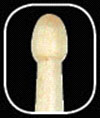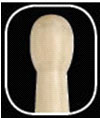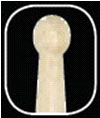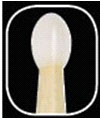A Guide To Drum Sticks
Having been playing drums for about eight years, I have heard and read a lot about drumsticks relating to length, width, type of wood, and the type of tip on the sticks. What I plan to do in this article is out line why there are so many types of sticks and what the different types are used for.
The Length Affects the balance and pivot point of all drumsticks. Longer sticks offer greater reach and leverage, while shorter sticks are easier to control and tend to feel quicker.
Thickness
There are four main components that make up a drumstick. They are responsible for the overall feel, balance and response of the drumstick.
The Shoulder Profile affects the weight distribution of the stick, and has an effect on the sense of rebound.
The Taper of the shoulder affects the feel and performance of a stick. A long taper provides more flex and a greater response, while a short taper is stiffer and offers additional strength.
And sizes, the five most basic sizes for drum sticks are:
7A
5A
5B
5S
2B
The number at the beginnings is basically the width of the stick, and it is measures in fractions of an inch. So a 5A stick is half an inch wide, similarly a 7A is a seventh of an inch and a 2B is the biggest being only a fraction away from an inch.
The letters that come after the width of the stick relate to what these sticks were used for when drumstick manufactures first started making sticks.
The A stands for Orchestral, and these sizes were used by drummers playing in orchestras at the time. The reason A was chosen over the letter O was because it looks too much like a zero.
The B stands for Band, so for Drums in mainly Jazz bands at the time, bigger sticks were required in order to cut through the rest of the music.
Finally the S stands for Street. Street players required sticks that are even bigger than the Orchestral and Band.
There are many more different sizes available than I have mentioned here because manufacturers have tried to create a long line of sticks so that everyone can use sticks they are comfortable with.
Width
The width of a stick affects the sound that the drum make once it has been hit. Thinner sticks are usually quieter and create a higher pitch in the drum, however because the stick is thinner and because it will forever be coming into contact with metal the thinner sticks are more likely to shatter or snap than the wider stick depending on how much of a heavy hitter you are. Thinner sticks are generally used by funkier players and even some of the gospel players because of the high pitched drum sounds they help to create.
The wider sticks create a deeper sound from the drum, and tend to be a lot louder. Because there is more mass in the stick more momentum can be produced from bigger sticks which is why some of the fastest drummers such as Thomas Lang use 2Bs which are among some of the widest sticks available. Heavier and thicker sticks are usually associated with rock players who hit the hardest as the sticks can take quite a beating before they start to shatter.
Why it is important to use sticks that you are comfortable with, if you want to create a certain sound you arent getting by tuning your drums alone, it is important to branch out and try other stick sizes, while it feels uncomfortable at first your hands will adapt and different stick sizes will feel natural the more you practice. This is important for aspiring musicians as you may be called on the play some styles that would sound infinitely better with a different choice of sticks.
Also if you get aches and pains in your hands after drumming or you persistently get blisters, bigger, thicker sticks can help you improve your technique stopping the blisters from occurring.
Tips
Tip shapes are the main factor that affects the overall sound the stick will make on drums and cymbals.
Teardrop Tip

Teardrop tips produce rich, deep and dark tones.
Barrel Tip

Barrel tips produce a full punchy sound. Great for louder volume situations.
Ball Tip

Ball tips produce a clean, bright and articulate sound.
Acorn Tip

Acorn tips produce a full, fat sound. Very responsive.
Oval Tip

Oval tips produce a broad, mid range sound due to tip length.
Nylon Tip

Nylon tips produce a brighter sound than wood tip models. More durable than wood tips. These are generally used on electric drum sets.
Types of wood also affect the sound that the sticks produce out of the drum.
Hickory is the most popular wood used for making drumsticks. Hickory is denser, heavier and more rigid than Maple. Hickory can also absorb a great amount of shock, which reduces hand and wrist fatigue. Dark, or "brown hickory", is found closer to the trees centre and is slightly denser and heavier than "white" hickory.
Maple is a much lighter and less dense wood than hickory. Maple can provide the feel of a big stick without the extra weight of a hickory stick. Maple sticks are primarily used for light, fast playing in low volume situations.